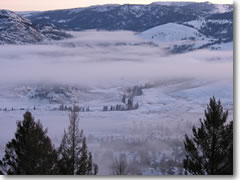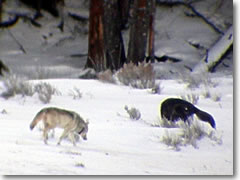The Winter Wolves of Yellowstone National Park
A winter trip to Yellowstone National Park to track the wolves

Since 1995, the Greater Yellowstone region has become home to the highest concentration of wolves in the world.
"We're going to follow that bald eagle up the river," said veteran Yellowstone guide Leslie Quinn as we watched the magnificent bird flap past.
Leslie threw into gear his bright yellow Bombadier—a vintage 1960s snowcoach shaped like a gumdrop reclining on tank treads—and crunched up the snow-packed road into the heart of the world's oldest national park.
Yellowstone in Winter
Elegant trumpeter swans glided between the ice-encumbered banks of the Madison River.
An American dipper—a tiny slate-colored bird that lives its entire life in the rapids, nesting in the lees of rocks and swimming with equal ease through the air or water—splashed in the rushing current, bobbing for insect larvae.
Elk picked their way though lodgepole pine up a snowy hillside.
A coyote trotted down the road toward us before turning to lope off into the woods.
Where the road curved along the foot of Mount Haynes, an obstinacy of bison—part of America's only surviving herd of wild buffalo—ranged along the riverbanks, some using their great shaggy heads to pile drive through several feet of snow to munch on the grasses beneath.

Yellowstone National Park is home to America's last remaining herd of truly wild bison.
A few miles on, Leslie hit the brakes to let another troop of buffalo amble along the road past us. We cowered excitedly in the Bombadier, popping out of the roof hatches to snap photographs of the beasts passing not ten feet away.
As we turned south to follow the Firehole River towards the Old Faithful Snow Lodge, fumeroles puffed on the opposite bank. Hot springs steamed the air as their waters bubbled and flowed down the to the river along rocky banks swirling with colors from the archaic bacteria that thrive on these thermal features.
This was Yellowstone in winter, and it felt like we had the entire park to ourselves.
Sunrise over the Yellowstone
"This is one of the premier times to come to the park," said George Bumann, a naturalist who teaches ecology, backpacking, and art courses for the Yellowstone Association (and can imitate the calls of more than 200 birds).

Fog flows through the Yellowstone River Valley like a glacier at the point where Hellroaring Creek doglegs out of the Absaroka Mountains.
I yawned. This was not out of boredom—my pen was flying across my notepad trying to keep up with George's flood of interesting facts—but because I had been roused from my warm bed at Mammoth Hot Springs Hotel well before dawn.
A 6:30am start allowed us to take in the sunrise from the overlook where Hellroaring Creek doglegs down from the Absaroka Mountains to join the Yellowstone River.
We watched the geothermal mists swirl through the valley below as sunlight flooded over the Bearthooths to awaken Yellowstone in a dawn chorus of Clark's nutcrackers, mountain chickadees, pine siskens, nuthatches, and distant ravens.
As the birdsong died down, George explained that it was on the slope below us that the last wolves in Yellowstone were pulled from their dens and killed in 1926. It would take 70 years, and much controversy, before 31 wild wolves were once again let loose in the park.
Running with the Wolves

The alpha male and alpha female of Yellowstone's Druid Peak pack of wolves (you can tell he's the alpha male because he keeps his tail stuck straight out; the beta male—not in the picture—keeps his tail hanging down.)
In the decade since reintroduction, Yellowstone's Lamar Valley—a cradle of wildlife often called "the Little Serengeti of the Americas"—has become the most densely populated wolf habitat in the world.
Wolf numbers have now swelled to more than 300 in the Greater Yellowstone area, and two hours after begrudgingly getting out of bed, I was peering through a roadside scope to watch members of the Druid Peak pack, not a quarter mile away, glide through the frost-velveted landscape of wild rye grass, sage, willow, and aspen above Soda Butte Creek.
The pack's charcoal beta male beat a path past some grazing bison—the pack had a fresh elk kill nearby, and no interest in molesting the shaggy giants—with the black alpha male and his silver-blonde alpha female mate trotting two dozen feet behind.
A trio of pups—full-sized, yet just nine months old—romped and gamboled behind, wrestling and chasing one another, pausing to sniff clumps of grass, then bursting into a flat-out run that usually ended with someone face-planting in an unexpectedly deep snowdrift.
When they got to a sun-lit plateau, the pack shifted into warp speed, streaking along faster than I could have imagined, disappearing into a stand of ice-glazed willow and aspen just as thick fog rolled back into the valley.
A nearby coyote sent up a series of tenor yips, and the now-invisible wolves answered in an eerie baritone howl. To me, the message seemed clear.
The wolves were letting their smaller cousin know: this was wolf territory now.
When You Go...

Though a few roads are open to cars, most of Yellowstone is accessible in winter only via snowcoach.
Though 96% of Yellowstone National Park (307-344-2117, www.nps.gov/yell) lies in Wyoming, its northern and western borders overlap into Montana and Idaho, making Bozeman, Montana the most convenient wintertime airport (» How to find cheap airfares).
Bozeman's about a 90-minute drive from the park's north gate at Gardiner (five miles from Mammoth Hot Springs Hotel, where lodging starts at $76) and the west gate at West Yellowstone (a 30-mile snowcoach ride from Old Faithful Snow Lodge; from $85—note, this is not the famous Old Faithful Inn, which is shuttered in winter, rather a modern hotel in the same complex just a few hundred yards from the world' most regular geyser).
I single those out because, of Yellowstone's nine lodges, they are the only two that remain open in winter. All in-park lodging is managed by Xanterra (866-439-7375, www.travelyellowstone.com), which has teamed with the venerable Yellowstone Association—a nonprofit helping visitors interpret the park since 1933 (307-344-2293, www.yellowstoneassociation.org)—to offer multi-day lodging and learning packages.
These packages bundle several nights at the historic inns with courses on wildlife, geology, and history while exploring Yellowstone by van, snowcoach, snowshoe, and ski. The four-night Winter Wolf Discovery package runs $515 per person.
Related Articles |
|
This article was by Reid Bramblett and last updated in June 2012.
All information was accurate at the time.
Copyright © 1998–2013 by Reid Bramblett. Author: Reid Bramblett.
